Advertisements
Advertisements
Question
A parallel-plate capacitor of capacitance 5 µF is connected to a battery of emf 6 V. The separation between the plates is 2 mm. (a) Find the charge on the positive plate. (b) Find the electric field between the plates. (c) A dielectric slab of thickness 1 mm and dielectric constant 5 is inserted into the gap to occupy the lower half of it. Find the capacitance of the new combination. (d) How much charge has flown through the battery after the slab is inserted?
Solution
For the given capacitor,
`C = 5 "uF"`
V = 6 V
`d = 2 "mm" = 2 xx 10^-3 "m"`
(a) The charge on the positive plate is calculated using q = CV.
Thus,
`q = 5 "uF" xx 6 V = 30 "uC"`
(b) The electric field between the plates of the capacitor is given by
`E = V/d = 3 xx 10^3 "V/m"`
(c) Separation between the plates of the capacitor, d = `2 xx 10^-3 "m"`
Dielectric constant of the dielectric inserted, k = 5
Thickness of the dielectric inserted, t = `1 xx 10^-3 "m"`
Now ,
Area of the plates of the capacitor `C = (∈_0A)/d`
⇒ `5 xx 10^-6 = (8.85 xx 10^-12 xx A)/(2 xx 10^-3)`
⇒ `10^4 = 8.85 xx A`
⇒ `A = 10^4 xx 1/8.85`
When the dielectric placed in it, the capacitance becomes
⇒ `C_1 = (∈_0A)/(d-t+t/k)`
⇒ `C_1 = (8.85 xx 10^-12 xx 10^4/8.85)/(2 xx 10^-3-10^-3+(10-3)/5)`
⇒ `C_1 = (8.85 xx 10^-12 xx 10^4/8.85)/(10^-3+(10-3)/5)`
⇒ `C_1 = (10^-12 xx 10^4 xx 5)/(6 xx 10^-3) = 8.33 "uF"`
(d)
The charge stored in the capacitor initially is given by
`C = 5 xx 10^-6 "F"`
Also ,
V = 6 V
Now ,
`Q = CV = 3 xx 10^-5 "F"`
⇒`Q = 30 "uC"`
The charge on the capacitor after inserting the dielectric slab is given by
`C_1 = 8.3 xx 10^-6 "F"`
`therefore Q^' = C_1V = 8.3 xx 6 xx 10^-6`
⇒ `Q^' = 50 "uC"`
Now ,
Charge flown , `Q^' - Q = 20 "uC"`
APPEARS IN
RELATED QUESTIONS
A bulb is connected in series with a variable capacitor and an AC source as shown. What happens to the brightness of the bulb when the key is plugged in and capacitance of the capacitor is gradually reduced?
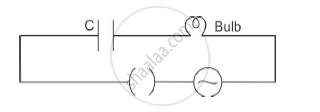
A spherical capacitor has an inner sphere of radius 12 cm and an outer sphere of radius 13 cm. The outer sphere is earthed and the inner sphere is given a charge of 2.5 µC. The space between the concentric spheres is filled with a liquid of dielectric constant 32.
(a) Determine the capacitance of the capacitor.
(b) What is the potential of the inner sphere?
(c) Compare the capacitance of this capacitor with that of an isolated sphere of radius 12 cm. Explain why the latter is much smaller.
A capacitor of unknown capacitance is connected across a battery of V volts. The charge stored in it is 300 μC. When potential across the capacitor is reduced by 100 V, the charge stored in it becomes 100 μC. Calculate The potential V and the unknown capacitance. What will be the charge stored in the capacitor if the voltage applied had increased by 100 V?
Three identical capacitors C1, C2 and C3 of capacitance 6 μF each are connected to a 12 V battery as shown.
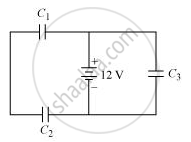
Find
(i) charge on each capacitor
(ii) equivalent capacitance of the network
(iii) energy stored in the network of capacitors
As `C = (1/V) Q` , can you say that the capacitance C is proportional to the charge Q?
A capacitor of capacitance 10 μF is connected to a battery of emf 2 V. It is found that it takes 50 ms for the charge of the capacitor to become 12.6 μC. Find the resistance of the circuit.
Each of the plates shown in figure has surface area `(96/∈_0) xx 10^-12` Fm on one side and the separation between the consecutive plates is 4⋅0 mm. The emf of the battery connected is 10 volts. Find the magnitude of the charge supplied by the battery to each of the plates connected to it.
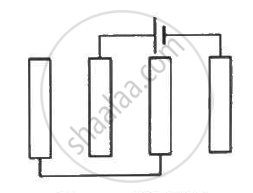
Consider the situation shown in the figure. The switch S is open for a long time and then closed. (a) Find the charge flown through the battery when the switch S is closed. (b) Find the work done by the battery.(c) Find the change in energy stored in the capacitors.(d) Find the heat developed in the system.
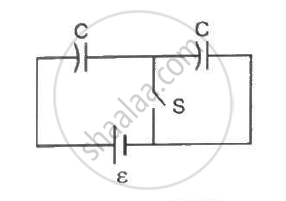
A 5⋅0 µF capacitor is charged to 12 V. The positive plate of this capacitor is now connected to the negative terminal of a 12 V battery and vice versa. Calculate the heat developed in the connecting wires.
A sphercial capacitor is made of two conducting spherical shells of radii a and b. The space between the shells is filled with a dielectric of dielectric constant K up to a radius c as shown in figure . Calculate the capacitance.
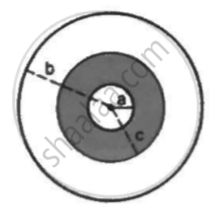
The variation of inductive reactance (XL) of an inductor with the frequency (f) of the ac source of 100 V and variable frequency is shown in fig.

(i) Calculate the self-inductance of the inductor.
(ii) When this inductor is used in series with a capacitor of unknown value and resistor of 10 Ω at 300 s–1, maximum power dissipation occurs in the circuit. Calculate the capacitance of the capacitor.
- Charge on each capacitor remains same and equals to the main charge supplied by the battery.
- Potential difference and energy distribute in the reverse ratio of capacitance.
- Effective capacitance is even les than the least of teh individual capacitances.
Three capacitors 2µF, 3µF, and 6µF are joined in series with each other. The equivalent capacitance is ____________.
Can the potential function have a maximum or minimum in free space?
A leaky parallel plate capacitor is filled completely with a material having dielectric constant K = 5 and electric conductivity σ = 7.4 × 10-12 Ω-1 m-1. If the charge on the plate at the instant t = 0 is q = 8.85 µC, then the leakage current at the instant t = 12 s is ______ × 10-1 µA.
A parallel plate capacitor (A) of capacitance C is charged by a battery to voltage V. The battery is disconnected and an uncharged capacitor (B) of capacitance 2C is connected across A. Find the ratio of final charges on A and B.
Read the following paragraph and answer the questions.
| A capacitor is a system of two conductors separated by an insulator. The two conductors have equal and opposite charges with a potential difference between them. The capacitance of a capacitor depends on the geometrical configuration (shape, size and separation) of the system and also on the nature of the insulator separating the two conductors. They are used to store charges. Like resistors, capacitors can be arranged in series or parallel or a combination of both to obtain the desired value of capacitance. |
- Find the equivalent capacitance between points A and B in the given diagram.

- A dielectric slab is inserted between the plates of the parallel plate capacitor. The electric field between the plates decreases. Explain.
- A capacitor A of capacitance C, having charge Q is connected across another uncharged capacitor B of capacitance 2C. Find an expression for (a) the potential difference across the combination and (b) the charge lost by capacitor A.
OR
Two slabs of dielectric constants 2K and K fill the space between the plates of a parallel plate capacitor of plate area A and plate separation d as shown in the figure. Find an expression for the capacitance of the system.
